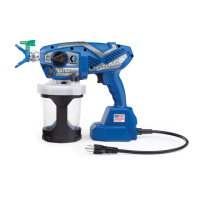For portable spray applications of water-based and oil-based
non-flammable architectural paints and coatings only.
Not approved for use in explosive atmospheres or hazardous locations.
3A4433B
EN
Important Safety Instructions
Read all warnings and instructions in this manual and on the unit. Be familiar with the
controls and the proper usage of the equipment. Save these instructions.
FIRE AND EXPLOSION HAZARD
Use only non-flammable or water-based
materials, or non-flammable paint thinners. Do
not use materials having flash points below
100°F (38°C). This includes, but is not limited to,
acetone, xylene, toluene, and naphtha. For
more information about your material, request
Safety Data Sheet (SDS) from the supplier.
Use oil-based materials outdoors or in a
well-ventilated indoor area with a flow of fresh air.
Operational video.
http://graco.com/hhsupport
Operation, Parts
Corded Airless
HandHeld Sprayers



